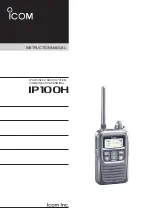
3
TK-980/981
1
3
+
–
7
6
13
15
5. INSTALLATION PLANNING – CONTROL STATIONS
5-1. Antenna system
Control station. The antenna system selection depends
on many factors and is beyond the scope of this manual.
Your KENWOOD dealer can help you select an antenna sys-
tem that will best serve your particular needs.
5-2. Radio location
Select a convenient location for your control station radio
which is as close as practical to the antenna cable entry
point. Secondly, use your system’s power supply (which
supplies the voltage and current required for your system).
Make sure sufficient air can flow around the radio and power
supply to allow adequate cooling.
SERVICE
This radio is designed for easy servicing. Refer to the
schematic diagrams, printed circuit board views, and align-
ment procedures contained in this manual.
Note
When you modify your radio as described in system set-
up, take the following precaution.
The rating of pin 7 (SB) of the accessory connector cable
(KCT-19) on the rear of the radio is 13.6V (1A). Insert a 1A
fuse if you use the SB pin for external equipment.
Accessory connector
cable (KCT-19)
If you do not intend to use the 3.5-mm jack for the exter-
nal speaker, fit the supplied speaker-jack cap (B09-0235-05)
to stop dust and sand getting in.
GENERAL / OPERATING FEATURES
Speaker-jack cap
(B09-0235-05)
1. Operation Features
The TK-980/981 is an 800MHz/900MHz band EFJ LTR™ -
compatible trunked radio designed to operate in both
trunking and conventional modes. The programmable fea-
tures are summarized.
This model can handle up to 32 systems with up to 250
groups in each system. The transceiver can be used in both
trunked mode and conventional mode. Systems, groups,
and their functions are programmed.
2. Transceiver Controls and Indicators (Fig. 1)
2-1. Front Panel Controls
All the keys on the front panel are momentary-type push
buttons. The functions of these keys are explained below.
• POWER key
Transceiver POWER key. When the power is switched
off, all the parameters, such as the system and group are
stored in memory. When the power is switched on again,
the transceiver returns to the previous conditions.
• SYSTEM UP/DOWN key (Programmable)
• SCAN key (Programmable)
• MONITOR key (Programmable)
• A, B, C and D key (Programmable)
• VOLUME UP/DOWN key (Programmable)
• BUSY/TX LED
The BUSY indicator (Green LED) shows that the group is
in use. The TX indicator (Red LED) shows that you are trans-
mitting.
2-2. Programmable Keys
The FPU (KPG-49D) enables programmable keys to se-
lect the following functions.
Auto tel, AUX-A, AUX-B (Only when voice scrambler is
not selected), DTMF ID (BOT), DTMF ID (EOT), Display char-
acter, Emergency (Only foot key), Function, Group down,
Group up, Home group, Horn alert, Key lock, Memory (RCL/
STO), Memory (RCL), Memory (STO), Message mode (Only
A key), Monitor A, Monitor B, Monitor C, Monitor D, Public
address, Redial, Scan, Scan del/add, Scan temporary delete,
Scrambler (Only when voice scrambler is selected), Send
GPS, System down, System up, TEL disconnect, Volume
down, Volume up and None.
These functions the FPU programs to the function keys
and described in the following sections.
• Auto TEL
Automatically connects available repeaters that are con-
nected to telephone circuits when operating as LTR system.
The time allocated to search for available repeaters is 60
seconds, after which connection failure occurs, a DTMF
tone is output and the function terminates.
If connection to an available circuit is made, only ID 253,
EOT or hang-up time-out can terminate the function.




































